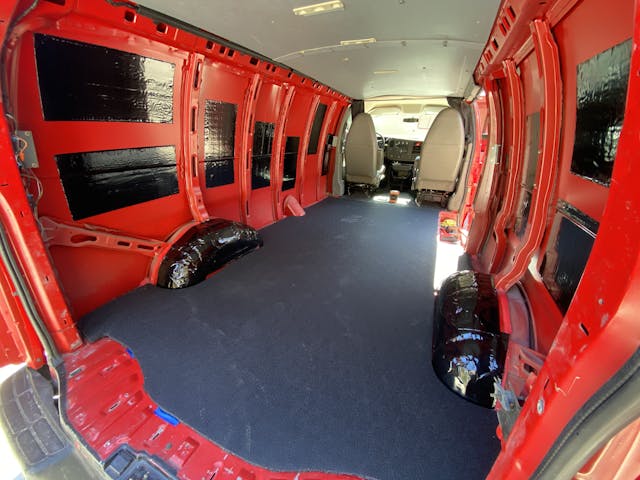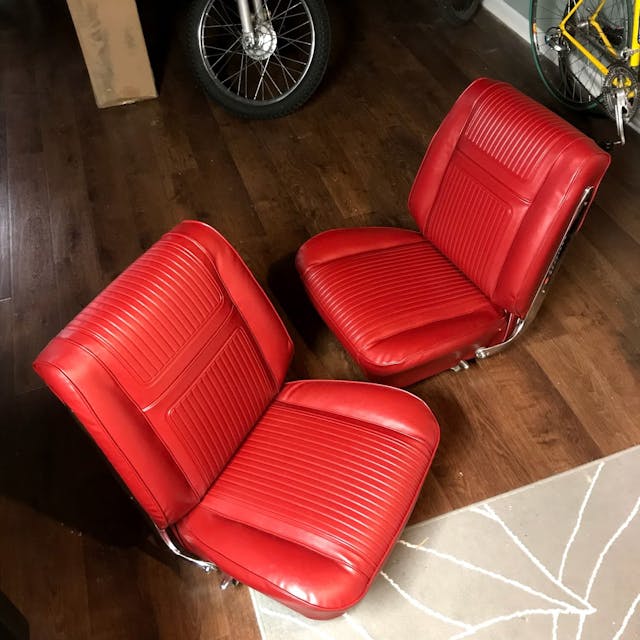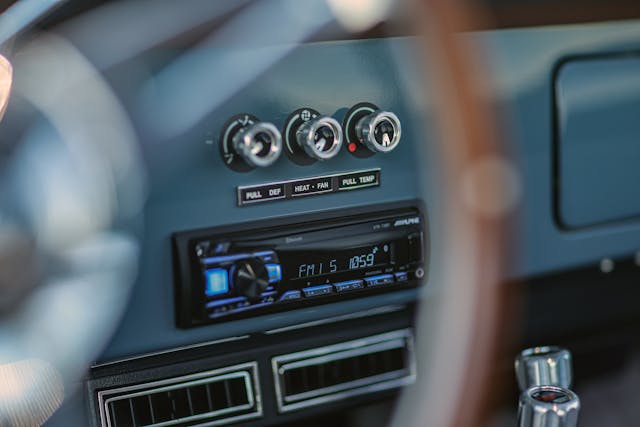8 DIY projects to make any car feel more luxurious
Not all of us can afford luxury cars. Heck, some of us can’t even afford nice versions of plebeian cars from 50 years ago. But even a tight budget doesn’t mean we can’t have nice things, though, and luxury is in the eye of the beholder. Instead of replacing your current ride with a luxury vehicle, you’re probably best served by making whatever you already own into the best version of itself.
Some enthusiasts may not think of DIY projects beyond those necessary to keep a vehicle running and drivable. Branching out into cosmetic and functional improvements is both fun and less stressful than the highly mechanical nature of projects under the hood.
Tackle a few of these eight ideas to add a little more comfort to your ride—and have the fun of accomplishing a new project, too.
Sound deadening

Often, a luxury car is one of the vehicles most disconnected from the road. Take, for instance, its lack of road noise. The difference between the sound of a door closing—a tin-can sound, in a tired economy car, or the bank-vault whump of a luxury car’s—is just the start.
With just a few sheets of stick-on sound-deadening like Dynamat or Kilmat can eliminate a surprising amount of noise for minimal effort. Remove door panels, stick sound deadener to the sheetmetal surfaces, reassemble, and off you go, quieter than ever.
You don’t need to cover every square inch of metal to notice the effects: you’ll actually experience diminishing returns past 60 percent coverage. Plan to add sound-deadening at least 25 percent of your interior sheetmetal to hear a difference. That 60 percent coverage will often remove 95 percent of the noise you want it to, so save a few dollars and some effort by not going too crazy.
New weatherstripping
Leaks are not luxe, whether they’re admitting wind noise or water. New weatherstripping can be fitted easily on the vast majority of cars and can make a dramatic difference in how the car feels. Doors shut tighter, windows seal better, and trunks are weathertight again.
New weatherstripping often also makes doors, windows, hoods, and trunks close better and more solidly. It can also get rid of rattles around windows and doorframes. For the effort it takes to put new foam rubber in place along the seams, the return is huge.
Refinished (or new) steering wheel

There are really only three touch-points in a car for the driver: seat, pedals, and steering wheel. Replacing upholstery can be complicated and expensive, and refreshing pedals is even more work, but changing a steering wheel is not bad.
Removing a vintage wheel is likely to require special tools but those can often be easily borrowed (with a deposit) from chain auto-parts stores. Even just sanding down, filling cracks, and painting a wheel can go a long way. Be sure, if you do this, to use the appropriate paint and clearcoat. You want durability and proper feel, neither of which is likely to come out of a traditional rattle can.
Fixing torn seats

Only five sentences ago I said re-upholstery can be difficult, but for the right DIY person, it is absolutely doable. New foam under original covers, or new covers alone, transform a seat and make driving enjoyable again. Having seat foam cling to your pants after you arrive at cars and coffee is not luxurious, after all.
Removing seats and dropping them off at an upholstery shop is DIY enough to qualify for this list, but if you are feeling adventurous, we encourage you to research doing seats yourself. Get those hog-ring pliers out and make that interior one that not only looks good but becomes something you can point at with pride.
Look into OEM+ mods

This term came into my life from the man who is better at it than anyone else: Sajeev Mehta. Simply put, OEM+ upgrades use parts that were built for your model but not installed on your particular car at the factory. For modern cars, think nicer stereos, or steering wheels with radio controls. For more vintage cars, a logical OEM+ changes could be switching your vintage bumpside Ford truck’s rear suspension to lighter duty leaf springs, because it isn’t used for work anymore and the factory-installed 3/4-ton leafs just make for a harsh ride.
Or maybe change from a two-barrel carb and manifold to a factory-spec four-barrel for period-correct fit and finish—and easy assembly, since you can follow the factory service manual. Beat that, aftermarket.
Weighted shifter/short shifter

So maybe I lied earlier when I said that a driver only has three touch-points. Some enthusiasts prefer four, since they want a transmission that requires manual persuasion to shift gears. If that’s your thing, than an upgrade to the shifter can totally change the driving experience.
I went OEM+ by using a three-speed shifter on a four-speed transmission in my Corvair, which equated to a short-throw unit and factory fit, but not everyone is so lucky. Your DIY upgrade could be as easy as a weighted shift knob in modern cars, or adding a new Hurst T-handle to your muscle car. Whatever it is, this could be the easiest bit of wrenching that will change how your car feels from the driver’s seat.
Fixing little rattles and squeaks
That loose piece of trim should be annoying: there is no reason for it to be loose. Items like this can be low-hanging fruit, and transform a beater into a vehicle to be proud of. Having a rattle- or squeak-free driving experience immediately changes your perception of any car, so taking the time to track down and properly affix or lubricate small parts and pieces is well worth your time.
A quick tip: The most common cause I’ve seen for squeaky suspension is when people tighten all the suspension bolts while the suspension is hanging. Many suspension bolts and fasteners should be tightened with the weight of the car on the suspension. Get everything snug, set the car down, and only then break out the torque wrench.
Stereo upgrade

Last but not least is an upgrade that is easier than ever to hide. Vintage cars have vintage audio, but modern speakers can be fit behind original speaker grilles, and Bluetooth receivers and amplifiers can be hidden in glove boxes or under seats. Totally stock appearance with modern or upgraded sound is attainable and not nearly as expensive as it once was.
Combine that with a few other items on this list and your car is going to feel nearly new, or at least a little more luxurious than what you are used to.
Check out the Hagerty Media homepage so you don’t miss a single story, or better yet, bookmark it.


I bought my 1967 Pontiac LeMans Convertible in April 1973 for $650. I have done numerous upgrades over the past almost 50 years. The ‘Shark’ was even stolen in 1977 and found in Eufaula Ala. 3 years later. Now the upgrades list: Went from 2 speed power glide to TH350, Flow Master dual exhaust, 4 bbl Holley then later an Eldelbrock, urethane bushings, front disc brakes off a 70 Monte Carlo, power brake booster, had a complete engine rebuild, painted all over PPG Deltron basecoat/clearcoat, Kenwood radio with Infinity speakers, MSD Blaster 2 coil, Mallory Unilite distributor, new cloth top, rebuilt front steering rack, faster ratio steering box, new hd springs, and a all aluminum 3 row radiator, rebuilt the front seat springs and foam, + many smaller things. I love working on all of my 5 cars. Even through all the cussing It was well worth the cost and time. I love my “Shark”.
The steering wheel. I’m going to do my husband’s car first. I love the dark woodgrain. And it makes the inside look so much better.
I would add new suspension bushes. They wear (like weatherstripping) slowly and so you get used to the worn and inadequate feel. Then when you replace them its a revelation. They are usually pretty cheap too.
The stereo upgrade has been a popular one with me on older cars.
I see where some of the photos are of a 65 Corvair Corsa. During my 7-year rebuild of my 66 Corsa, I did several of these things. Sound deadening is under the carpet and can’t be seen. Of course, in a convertible not as efficacious as in a coupe. New steering wheel in the original form, had all the seats rebuilt with better and firmer foam, and those are now far more comfortable. Took some doing, but on the undercarriage found a coating that looked exactly like the factory original, but is of a more modern polymer used in pickup bedliners. It will not deteriorate and flake off like the old one did. The gearshift lever change really isn’t all that necessary. The original 4-speed linkage works just fine. It’s not as though there’s a need to speed shift anyway. It doesn’t accomplish anything. It got new weatherstripping and seals as part of the rebuild. No real point in doing a stereo upgrade — it’s a convertible and improved sound would still have to fight with normal convertible noise. Replacing all the perished rubber in the suspension, and that really improved driveability. It’s a real treat to drive now.
Some time back I started discontenting newer cars. All those things you get stuck with on newer vehicles. Sound systems and those TV screen things are at the top of the list. Anyway between one thing and another got three hundred pounds out of a Camaro. This helps offset roll cages and that sort of thing. If you drop the headliner you can disconnect that thing on the roof that is used to track your every movement. Follow the wiring and disconnect that as well.
Stereo is a dual exhaust system, too loud, earplugs.
New carpets.
I did a stereo upgrade 45 years ago when I added a factory am/fm 8 Track to my 73 Mach 1, you mean another upgrade?
Up-dating the sound system in my ’99 Z28 allowed me have Bluetooth for my phone and a rear-view, back-up camera.
Huge +1 on squeaks and weather stripping, but c’mon, no mention of curb feelers? or the 3 ft wide sectioned rear-view mirror mounted near the top of the windshield? Those were so big, they practically doubled as a sun visor 😀
I never realized how bad my shift linkage was until I put a short shift and weighted knob in on my E30. The difference was well worth the effort.
Upgrade the the headlights. Install modern disc brakes on a drum brake car.
Great project suggestions!
All of the above good. My 72 Vette has has everything replaced minus the motor. Sensors? My sight, hearing, smell are still intact. That being said I do have 2 M-3’s. Sensors are a part of life with these.
This article hit all the key areas. I’ve done each, with huge satisfaction at every turn. The point on the driver interface surfaces is key. That would include the shift knob. John Burton’s comment on not cutting OEM doors and panels for speakers is key, as is John Grubenmann’s observation on a thorough cleaning. The other benefit of a thorough cleaning is identification of hidden issues that provide additional satisfaction in correcting. I would even expand the extent of the cleaning to taking all the exterior light lenses off and polishing the reflecting surfaces as well as cleaning the light lens’ interiors. That simple step adds a nighttime sparkle at almost no cost.
Number 9: Replace the stock wheels with upgraded OEM wheels or caps. Some aftermarket vintage wheels are also a great look and the wider tires fit and handle better. I changed out my 14″x 7″ stock wheels and caps on my 67 Firebird, for 15″x 8″ Rally wheels with chrome rims (instead of trim rings, which rattle). They look great and the handling improved.